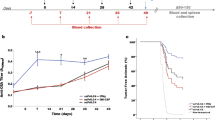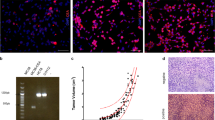Abstract
Carcinoembryonic antigen (CEA) is expressed during embryonic life and in low level during adult life. Consequently, the CEA is recognized by the immune system as a self-antigen and thus CEA-expressing tumors are tolerated. Previously, we constructed a single chain variable fragment using the 6.C4 (scFv6.C4) hybridoma cell line, which gave rise to antibodies able to recognize CEA when C57/Bl6 mice were immunized. Here, the scFv6.C4 ability to prevent the CEA-expressing tumor growth was assessed in CEA-expressing transgenic mice CEA2682. CEA2682 mice immunized with the scFv6.C4 expressing plasmid vector (uP/PS-scFv6.C4) by electroporation gave rise to the CEA-specific AB3 antibody after the third immunization. Sera from immunized mice reacted with CEA-expressing human colorectal cell lines CO112, HCT-8, and LISP-1, as well as with murine melanoma B16F10 cells expressing CEA (B16F10-CEA). Cytotoxic T lymphocytes (CTL) from uP/PS-scFv6.C4 immunized mice lysed B16F10-CEA (56.7%) and B16F10 expressing scFv6.C4 (B16F10-scFv6.C4) (46.7%) cells, against CTL from uP-immunized mice (10%). After the last immunization, 5 × 105 B16F10-CEA cells were injected into the left flank. All mice immunized with the uP empty vector died within 40 days, but uP/PS-scFv6.C4 vaccinated mice (40%) remained free of tumor for more than 100 days. Splenocytes obtained from uP/PS-scFv6.C4 vaccinated mice showed higher T-cell proliferative activity than those from uP vaccinated mice. Collectively, DNA vaccination with the uP-PS/scFv6.C4 plasmid vector was able to give rise to specific humoral and cellular responses, which were sufficient to retard growth and/or eliminate the injected B16F10-CEA cells.




Similar content being viewed by others
Abbreviations
- B16F10-CEA:
-
Murine melanoma cell line B16F10 expressing CEA
- B16F10-scFv6.C4:
-
Murine melanoma cell line B16F10 expressing scFv6.C4
- CEA:
-
Carcinoembryonic antigen
- CEA2682:
-
CEA-expressing transgenic mice
- CFSE:
-
Carboxyfluorescein diacetate succinimidyl ester
- FAPESP:
-
Sao Paulo research foundation
- RPMIc:
-
RPMI 1640 medium with supplements
- SB:
-
Sleeping beauty
- scFv:
-
Single-chain variable fragment
- scFv6.C4:
-
Single-chain variable fragment 6.C4
- SD:
-
Standard deviation
- uP/PS-scFv6.C4:
-
scFv6.C4 expressing plasmid vector
References
Thompson JA, Grunert F, Zimmermann W (1991) Carcinoembryonic antigen gene family: molecular biology and clinical perspectives. J Clin Lab Anal 5:344–366
Hammarström S (1999) The carcinoembryonic antigen (CEA) family: structures, suggested functions and expression in normal and malignant tissues. Semin Cancer Biol 9:67–81. doi:10.1006/scbi.1998.0119
Ura Y, Ochi Y, Hamazu M et al (1985) Studies on circulating antibody against carcinoembryonic antigen (CEA) and CEA-like antigen in cancer patients. Cancer Lett 25:283–295
Konstadoulakis MM, Syrigos KN, Albanopoulos C et al (1994) The presence of anti-carcinoembryonic antigen (CEA) antibodies in the sera of patients with gastrointestinal malignancies. J Clin Immunol 14:310–313
Albanopoulos K, Armakolas A, Konstadoulakis MM et al (2000) Prognostic significance of circulating antibodies against carcinoembryonic antigen (anti-CEA) in patients with colon cancer. Am J Gastroenterol 95:1056–1061. doi:10.1111/j.1572-0241.2000.01982.x
Haidopoulos D, Konstadoulakis MM, Antonakis PT et al (2000) Circulating anti-CEA antibodies in the sera of patients with breast cancer. Eur J Surg Oncol 26:742–746. doi:10.1053/ejso.2000.0996
Ladd J, Lu H, Taylor AD et al (2009) Direct detection of carcinoembryonic antigen autoantibodies in clinical human serum samples using a surface plasmon resonance sensor. Colloids Surf B Biointerfaces 70:1–6. doi:10.1016/j.colsurfb.2008.11.032
Chatterjee SK, Tripathi PK, Chakraborty M et al (1998) Molecular mimicry of carcinoembryonic antigen by peptides derived from the structure of an anti-idiotype antibody. Cancer Res 58:1217–1224
Tsujisaki M, Hinoda Y, Tokuchi S et al (1993) The analysis of internal image-bearing anti-idiotypic monoclonal antibody in relation to carcinoembryonic antigen. J Immunol 150:508–516
Gaida FJ, Pieper D, Roder UW et al (1993) Molecular characterization of a cloned idiotypic cascade containing a network antigenic determinant specific for the human carcinoembryonic antigen. J Biol Chem 268:14138–14145
de Moraes JZ, Carneiro CR, Buchegger F et al (1992) Induction of an immune response through the idiotypic network with monoclonal anti-idiotype antibodies in the carcinoembryonic antigen system. J Cell Biochem 50:324–335. doi:10.1002/jcb.240500313
Tripathi PK, Qin H, Deng S et al (1998) Antigen mimicry by an anti-idiotypic antibody single chain variable fragment. Mol Immunol 35:853–863
Pignatari GC, Takeshita D, Parise CB et al (2007) Carcinoembryonic antigen (CEA) mimicry by an anti-idiotypic scFv isolated from anti-Id 6.C4 hybridoma. J Biotechnol 127:615–625. doi:10.1016/j.jbiotec.2006.08.007
Schwegler C, Dorn-Beineke A, Nittka S et al (2005) Monoclonal anti-idiotype antibody 6G6.C4 fused to GM-CSF is capable of breaking tolerance to carcinoembryonic antigen (CEA) in CEA—transgenic mice. Cancer Res 65:1925–1933. doi:10.1158/0008-5472.CAN-04-3591
Tsujisaki M, Imai K, Tokuchi S et al (1991) Induction of antigen-specific immune response with use of anti-idiotypic monoclonal antibodies to anti-carcinoembryonic antigen antibodies. Cancer Res 51:2599–2604
Losman MJ, Novick KE, Goldenberg DM, Monestier M (1994) Mimicry of a carcinoembryonic antigen epitope by a rat monoclonal anti-idiotype antibody. Int J Cancer 56:580–584
Foon KA, John WJ, Chakraborty M et al (1999) Clinical and immune responses in resected colon cancer patients treated with anti-idiotype monoclonal antibody vaccine that mimics the carcinoembryonic antigen. J Clin Oncol 17:2889–2895
Foon KA, Chakraborty M, John WJ et al (1995) Immune response to the carcinoembryonic antigen in patients treated with an anti-idiotype antibody vaccine. J Clin Invest 96:334–342. doi:10.1172/JCI118039
Wagner U, Kohler S, Reinartz S et al (2001) Immunological consolidation of ovarian carcinoma recurrences with monoclonal anti-idiotype antibody ACA125: immune responses and survival in palliative treatment. See the biology behind: K. A. Foon and M. Bhattacharya-Chatterjee, are solid tumor anti-idio. Clin Cancer Res 7:1154–1162
Alfonso M, Diaz A, Hernandez AM et al (2002) An anti-idiotype vaccine elicits a specific response to N-glycolyl sialic acid residues of glycoconjugates in melanoma patients. J Immunol 168:2523–2529
Reinartz S, Wagner U (2004) Current approaches in ovarian cancer vaccines. Minerva Ginecol 56:515–527
de Moraes JZ, Gesztesi JL, Westermann P et al (1994) Anti-idiotypic monoclonal antibody AB3, reacting with the primary antigen (CEA), can localize in human colon-carcinoma xenografts as efficiently as AB1. Int J Cancer 57:586–591
Eades-Perner A-M, Van der Putten H, Hirth A et al (1994) Mice transgenic for the human carcinoembryonic antigen gene maintain its spatiotemporal expresion pattern. Cancer Res 54:4169–4176
Sacramento CB, Cantagalli VD, Grings M et al (2009) Granulocyte-macrophage colony-stimulating factor gene based therapy for acute limb ischemia in a mouse model. J Gene Med 11:345–353. doi:10.1002/jgm.1298
Pelegrin A, Terskikh A, Hayoz D et al (1992) Human carcinoembryonic antigen cDNA expressed in rat carcinoma cells can function as target antigen for tumor localization of antibodies in nude rats and as rejection antigen in syngeneic rats. Int J Cancer 52:110–119
Aronovich EL, Bell JB, Belur LR et al (2007) Prolonged expression of a lysosomal enzyme in mouse liver after Sleeping Beauty transposon-mediated gene delivery: implications for non-viral gene therapy of mucopolysaccharidoses. J Gene Med 9:403–415. doi:10.1002/jgm.1028
Mach JP, Carrel S, Merenda C et al (1974) In vivo localisation of radiolabelled antibodies to carcinoembryonic antigen in human colon carcinoma grafted into nude mice. Nature 248:704–706
Tompkins WA, Watrach AM, Schmale JD et al (1974) Cultural and antigenic properties of newly established cell strains derived from adenocarcinomas of the human colon and rectum. J Natl Cancer Inst 52:1101–1110
Solimene AC, Carneiro CR, Melati I, Lopes JD (2001) Functional differences between two morphologically distinct cell subpopulations within a human colorectal carcinoma cell line. Braz J Med Biol Res 34:653–661
Fidler IJ (1975) Biological behavior of malignant melanoma cells correlated to their survival in vivo. Cancer Res 35:218–224
Parise CB, Lisboa B, Takeshita D et al (2008) Humoral immune response after genetic immunization is consistently improved by electroporation. Vaccine 26:3812–3817. doi:10.1016/j.vaccine.2008.05.029
Rice J, Ottensmeier CH, Stevenson FK (2008) DNA vaccines: precision tools for activating effective immunity against cancer. Nat Rev Cancer 8:108–120. doi:10.1038/nrc2326
Gurunathan S, Klinman DM, Seder RA (2000) DNA vaccines: immunology, application, and optimization. Annu Rev Immunol 18:927–974
Bodles-Brakhop AM, Heller R, Draghia-Akli R (2009) Electroporation for the delivery of DNA-based vaccines and immunotherapeutics: current clinical developments. Mol Ther 17:585–592. doi:10.1038/mt.2009.5
Overwijk WW, Restifo NP (2001) B16 as a mouse model for human melanoma. Curr Protoc Immunol. doi:10.1002/0471142735.im2001s39
Chong G, Bhatnagar A, Cunningham D et al (2006) Phase III trial of 5-fluorouracil and leucovorin plus either 3H1 anti-idiotype monoclonal antibody or placebo in patients with advanced colorectal cancer. Ann Oncol 17:437–442. doi:10.1093/annonc/mdj090
Acknowledgements
Priscila M. A. Denapoli and Bianca F. Zanetti were recipients of the Brazilian National Council for Scientific and Technological Development (CNPq) and São Paulo Research Foundation (FAPESP) scholarships, respectively.
Funding
This study was funded by FAPESP (Grant Number: 2012/21861-1).
Author information
Authors and Affiliations
Corresponding author
Ethics declarations
Conflict of interest
The authors declare that they have no conflict of interest.
Rights and permissions
About this article
Cite this article
Denapoli, P.M.A., Zanetti, B.F., dos Santos, A.A. et al. Preventive DNA vaccination against CEA-expressing tumors with anti-idiotypic scFv6.C4 DNA in CEA-expressing transgenic mice. Cancer Immunol Immunother 66, 333–342 (2017). https://doi.org/10.1007/s00262-016-1940-4
Received:
Accepted:
Published:
Issue Date:
DOI: https://doi.org/10.1007/s00262-016-1940-4




